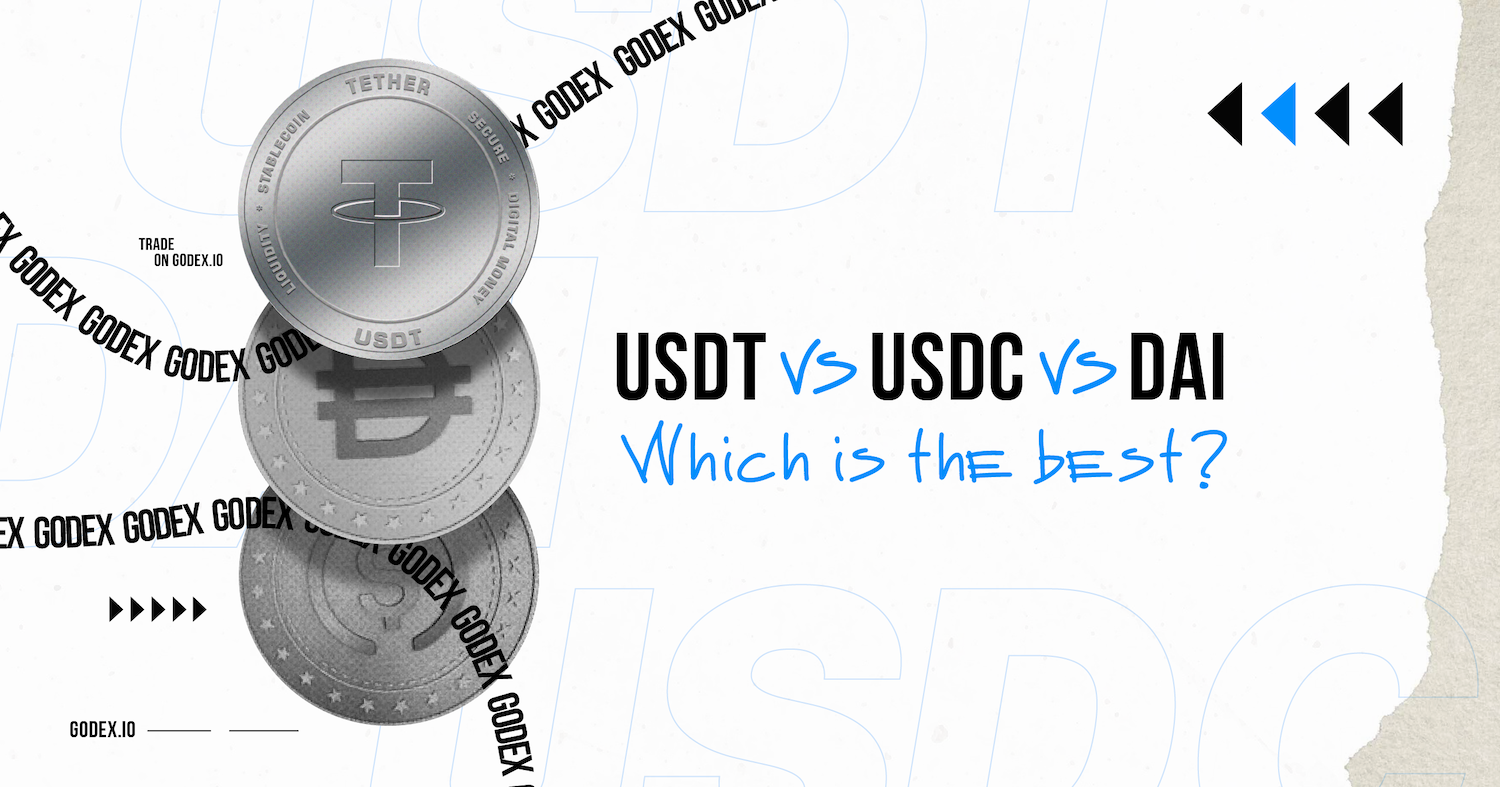Table of Contents
What is Stablecoin?
Stablecoin is a type of cryptocurrency characterized by stability, which is achieved by pegging to fiat currencies such as USD, CNY, EUR or JPY, and sometimes even to real assets such as gold or oil. As a result, stablecoin prices are not as volatile as the prices of typical cryptocurrencies such as Bitcoin.
Due to the risks associated with volatility, many service and product providers are reluctant to get involved with cryptocurrency. In this case, stablecoins came in handy.
Different stablecoins use different strategies to achieve price stability. Some are centralized, others are decentralized.
Stablecoin prices remain stable depending on which fiat currency supports them. For example, the USDT cryptocurrency is “pegged” to the US dollar and its price is always equal to the dollar exchange rate. This means that for one US dollar, you will always get one USDT.
What is USDT cryptocurrency?
USDT is one of the oldest and perhaps the most popular stablecoins. It has a huge amount of liquidity on various exchanges and ranks among the top cryptocurrencies in terms of market capitalization.
Tether, which issued USDT, claims that the stablecoin is backed by the real dollars reserves (“collateral”) or real assets. These real dollars are off-chain, meaning they are in a real place controlled by a centralized third party. By having this cache in the bank’s secure vault, investors can rest assured that their pegs are indeed worth 1 apiece while maintaining a stable price.
The stablecoin accounts for a whopping 48% of all cryptocurrency trading. There is only one problem: Tether Ltd. has never conclusively proven that the currency is indeed fully collateralized, which raises doubts among investors.
Although, of course, USDT remains a good solution for those who want to invest in cryptocurrency, but who are deterred by its volatility. Precisely because of its permanence, this coin is often used by investors as a trading pair on exchanges, where it can protect investors from risks and help to slowly increase the dollar value of their portfolio.
What is USDC cryptocurrency?
USD Coin (USDC) is a collaboration between Coinbase and Circle. This cryptocurrency belongs to stablecoins, the price of which, as in the case of USDT, is pegged to the US dollar rate.
But you may be wondering: why create another stablecoin pegged to the dollar? The fact is that as a result of a number of negative factors and Tether’s weak reputation, traders and investors began to look for other, more transparent and reliable options for stablecoins.
Being an ERC-20 token, USD Coin operates through the Ethereum network. Although USDC transactions can also be executed through the Algorand, Stellar and Solana infrastructures.
On the technical side, the USDC is unlikely to have anything special. It is also not a brand new coin compared to its competitors, as there are already other stablecoins pegged to the dollar, such as the Gemini dollar, Paxos and True USD. But, nevertheless, it has some peculiarities:
- Regulation. The parent company of USDC is a US registered company of Money Service, which means it is regulated by the government’s anti-money-laundering network.
- Audit. USDC is being audited by Grant Thornton, one of the world’s leading professional services network of independent accounting and consulting member firms.
- Speed. Sending Fiat to people and institutions can take a long time when banks are involved. Compared to sending fiat currency through banks and various services, USDC transactions benefit from their stability and speed.
Like Tether, Circle, the company behind USDC, actually holds the USD amount to support the stablecoin. However, unlike its massive competitor, Circle provides complete financial transparency, which is supported by the reporting of independent auditors. And if investors desire, they can redeem their US dollars by returning USDC tokens and withdrawing them from circulation. And later, if investors wish, they can redeem their US dollars by returning USDC tokens and withdrawing them from circulation. So which stablecoin is better?
USDC vs USDT
USDT is indeed one of the first stablecoins and clearly surpasses USDC in terms of its liquidity and volumes. However, size is not everything. Regulatory issues and ambiguity around Tether have fueled feelings of mistrust towards the stablecoin. Whereas the darling of regulators, USD Coin has become a popular alternative that people can’t help but compare to USDT.
First, USDC and USDT are centralized stablecoins. USD Coin is issued and operated by the Center Consortium, and USDT by Tether Holdings Limited.
Regular and independent audits prove that USDC is pegged to US dollars at a 1: 1 ratio. This, of course, cannot but inspire confidence in this coin and a sense of stability (which should be when dealing with stablecoins).
The reliability of the USDC was backed up by the latest news of a partnership with Visa and Crypto.com, allowing payments in USDC currency directly through the Visa payment system. This is undoubtedly a big step and another coin in the treasury of USDC benefits.
On the other hand, USDT, with its cloudy reputation, incomprehensible relationship with Bitfinex, litigation and attempts to confirm the existence of real assets. Surprisingly, after so many years of litigation, in which even the US Department of Justice was involved, Tether was only able to submit a dubious report, which also raises questions.
The report consists of two chart pies with a very vague and meager explanation:
Well, I don’t know, if this is some kind of trick, then in such an amount of time it was possible to come up with something more believable. According to the chart, out of 75% of liquid assets, only 3.87% are registered as cash, while 65% of the total is some kind of mysterious “commercial paper”.
At the same time, Tether insists that this single-page report should close all questions and clean up the company’s reputation.
Perhaps it was all Tether FUD and nothing to worry about. Although it doesn’t look quite like that. Either way, USDT can still be a good tool to trade quickly. When it comes to long-term ownership or interest on loans, USDC is your best bet. However, perhaps we jumped to conclusions, because there is still DAI!
What is DAI – Decentralized Stablecoin
You may be wondering why you need another stablecoin on the Ethereum blockchain when there is already an almost perfect USDC. Well, because he’s not perfect.
In fact, his cooperation with law enforcement agencies simultaneously serves as a protection for investors and can become a trap, because at their, of course, a reasonable request, Circle can freeze funds. Moreover, there have already been such precedents. On the one hand, from an ethical point of view, it’s right, on the other, it runs counter to the idea of decentralization of power, which the crypto space preaches.
Therefore, in the arsenal of stablecoins there is a completely decentralized, according to the creators, DAI. DAI is a product of MakerDAO, a decentralized lending platform operated by MKR token holders.
To mint DAI, a trader provides collateral to MakerDAO. Interestingly, unlike some other stablecoins that work on the same principle, Maker accepts many types of collateral, including coins such as ETH, BAT, and WBTC.
However, if you deposit cryptocurrency equal to $150, you can take 100 DAI. Remember that any stablecoin pegged to the dollar will strive to maintain a 1:1 ratio. Why then the number of DAI is 100 and not 150? The fact is that this is how MakerDAO protects itself from the risks associated with cryptocurrency volatility.
In a decentralized ecosystem, smart contracts and game theory help maintain a relatively stable value for DAI. In addition, DAI is functionally identical to Fiat-backed stablecoins.
DAI tokens can be used in the same way as other stablecoins: for savings (which cannot be withdrawn), instant international money transfers 24/7 and financial transparency.
Conclusion: USDT vs USDC and DAI – which is the best?
Considering the above, we can conclude that it is still too early to write off USDT, but for long-term investments, one should refrain for now. Alternatively, currencies with a more transparent financial system and a better reputation, such as USDC and DAI, can be used for this purpose. And if absolute decentralization is important to you, DAI is the best option for you.
Start a Cryptocurrency exchange
Try our crypto exchange platform
Disclaimer: Please keep in mind that the content of this article is not financial or investing advice. The information provided is the author’s opinion only and should not be considered as direct recommendations for trading or investment. Any article reader or website visitor should consider multiple viewpoints and become familiar with all local regulations before cryptocurrency investment. We do not make any warranties about reliability and accuracy of this information.
 Peter Moore
Peter Moore 
Read more
Ripple (XRP) price has been widely discussed by the cryptocurrency community since it has gained public interest in 2017, even though it was founded by Chris Larsen and Jed McCaleb years before. The platform offers innovative blockchain solutions for the banking sector and has the potential to disrupt the whole finance industry. In recent years, […]
In this article we will talk about Ripple (XRP) and its price prediction. What is Ripple (XRP) Ripple is a San Francisco-based startup that was launched in 2012 by Ripple Labs as a global network both for cross-currency and gross payments. Ripple history began in 2004 with the discussions around the digital coin in the […]
You may well think that an article dedicated to a Tether price prediction or the Tether price in general is a little bit strange — it is a stablecoin after all. However, the price of Tether does fluctuate significantly, although it is nowhere near as volatile as non-stablecoin cryptos. This means that staying up to […]
In the article we share our vision at Zcash cryptocurrency main features and add several price predictions. As cryptocurrencies gain global acceptance and decentralisation slowly enters our lives, privacy becomes the main concern when talking about blockchain adoption. It is no secret that distributed ledger is by far the most secure and transparent technology ever […]
Chiliz coin (CHZ) offers a compelling opportunity for traders interested in the intersection of blockchain technology and sports. By enabling fans to influence team decisions through the Socios app, Chiliz directly monetizes fan engagement and connects with major sports teams like Juventus and Paris Saint-Germain. These partnerships not only enhance the platform’s visibility but also […]
The exponential growth of Bitcoin Satoshi Vision (BSV) against the general bear trend on the cryptocurrency market in autumn 2019 has impressed the community. Due to the increasing market capitalization, the newly emerged altcoin was ranked 5th on CoinMarketCap and managed to maintain its high position at the beginning of 2020. In the article we […]